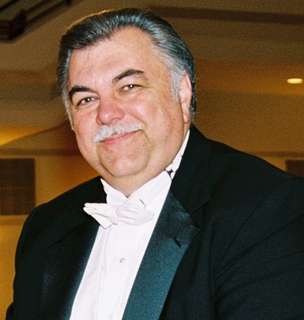|
Back
Süsssmayr’s Folly And The “Real” War Requiem New York
Avery Fisher Hall, Lincoln Centre
06/14/2009 -
Josef Haydn: Mass No. 9 in C Major (“Paukenmesse”)
Wolfgang Amadeus Mozart: Requiem in D Minor, K. 626 (Levin Edition)
Cynthia Douglas (Soprano), Erin Elizabeth Smith (Mezzo-soprano), Steven Sanders (Tenor), Noel Bouley (Bass)
Texas Master Chorale, Brad Bouley (Conductor and Artistic Director), Distinguished Concerts Orchestra International, Jonathan Griffith (DCNY Artistic Director and Principal Conductor)

Brad Bouley (© Gray James)
Spare a tear, if you will, for Franz Xaver Süssmayr. Over the past two-and-a-half centuries, this poor young composer was not only blamed, but censured for sloppily finishing Mozart’s unfinished Requiem. Not only did he botch some sections, but he was accused of forging Mozart’s autograph and overlooking his late teacher’s instructions.
All of which may have been true. But remember that Süssmayr was probably Constanze Mozart’s third choice to compose the endings. Even worse, he had to rush through the job, being nagged by Constanze—known to her Jewish friends as “the Tyrolean kvetch”—and was under the tyrannical influence of the very influential Salieri, Mozart’s rival.
So if the wretched Mr. Süssmayr has gone down in history as the “spoiler”, he probably had the best intentions in mind. Circumstances simply weren’t in his favor.
Why did nobody touch the work since that time? Actually Brahms made another version (which didn’t fly) and others may have tried to fix the piece. But the until recently, this was the Mozart Requiem which everybody knew and loved. The legends and the heavenly opening (quoted by Rmisky-Korsakov in his own version with piano for Mozart and Salieri) were enough.
That changed several years ago, when the noted Professor Robert Levin redid the weaker portions of the Requiem, adding a large fugue (from Mozart’s notes), extending portions of the “Hosannah” from the Sanctus portion, and thinning out some of Süsssmayr’s thickened orchestration.
This was the version performed yesterday afternoon by the grandiloquently dubbed Texas Master Chorale and an orchestra no less regally dubbed “Distinguished Concerts Orchestra International.” The latter is based in New York, and is probably a pickup group, but they played splendidly. The former is from somewhere in Texas and were quite a massive handful (no names were listed, but they seemed to have 70-odd singers). They were all under the baton of Jonathan Griffith, the co-founder and Artistic Director of the orchestra.
While reluctantly giving up a sunny Sunday for the concert, I look forward to the Levin edition, though only two major changes were noticed, for reasons below.
The longish fugue attached to the “Amen” of the Lacrimosa was a little disconcerting at first. Mainly because the opening of the Lacrimosa is such a gentle eulogy, and because the following crescendo and diminuendo is so touching. Thus, a fugue—apparently placed here since the other sections ended fugally—was something of a technical superfluity. It started with two melodies and developed more like a fughetta, but Professor Levin obviously provided all the Mozartean techniques to make it work.
The other section was an extension of the “Hosannah” from Sanctus which took away the jolt I always feel when the Benedictus starts. It is probably better music, as is the smoothing out of some measures from the opening section, but one does become accustomed to the older version.
Perhaps Professor Levin’s main contribution was to thin out the massive orchestral forces, giving a chamber-like music to the piece, but this was difficult to tell. Not for the orchestra, which had the right forces, some excellent soloists (the basset horn solo was appealing even with one or two minor fluffs) and a terrific brisk tempo.
But nothing was thinned out from the Texas Master Chorale, whose voices overwhelmed the orchestra in every movement. They were fine, blazing away, pitch perfect, but the balance couldn’t be right.
The four soloists varied in quality. I hate to say that Cynthia Douglas is wasting her time running the music department of Texas’s Cypress Ranch High School, but her voice is very professional. It was a bit on the light side for her Haydn, but in the Mozart, she gave a lyrical faultless performance.
Ditto for the finest of all, tenor Steven Sanders. He had almost a heldentenor gamut, but for the most part was forward, eloquent and always on target.
Mezzo Erin Elizabeth Smith was fine in her ensemble work though a bit weak as soloist. “Bass” Noel Bouley is obviously a baritone, for he could rarely projected the lower ranges.
The Requiem was the second mass of the day, the first being a “real” war requiem (not Britten’s peacenik essay played this week). Haydn set it to trumpets, drums, a military feel, and called it “Mass in Wartime”. Its purpose was to ask God to help the Austrians go against that upstart 27-year-old Corsican General named Bonaparte, and Haydn did his best to roll the drums, ring the trumpets and write as many fugues as possible.
That mass was conducted by Brad Bouley, the force behind the Texas Master Choir, and he gave it all the impetus which the work commands. Still, next to the Mozart, the Haydn Mass was rather pedestrian. Mozart’s Requiem, whether finished by Mozart’s student or an eminent professor, will always remain the lodestone of the most spiritual music ever created.
Harry Rolnick
|